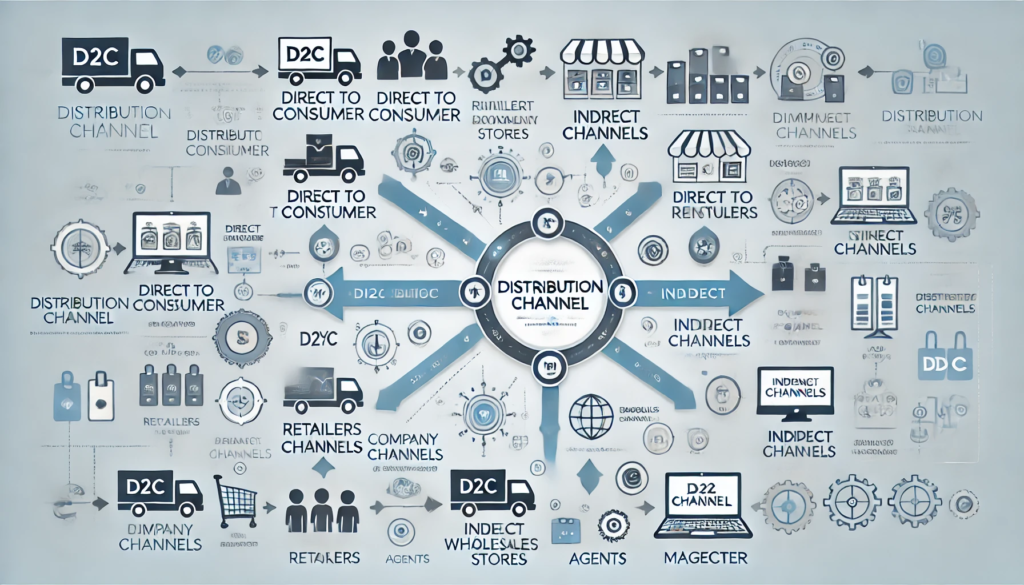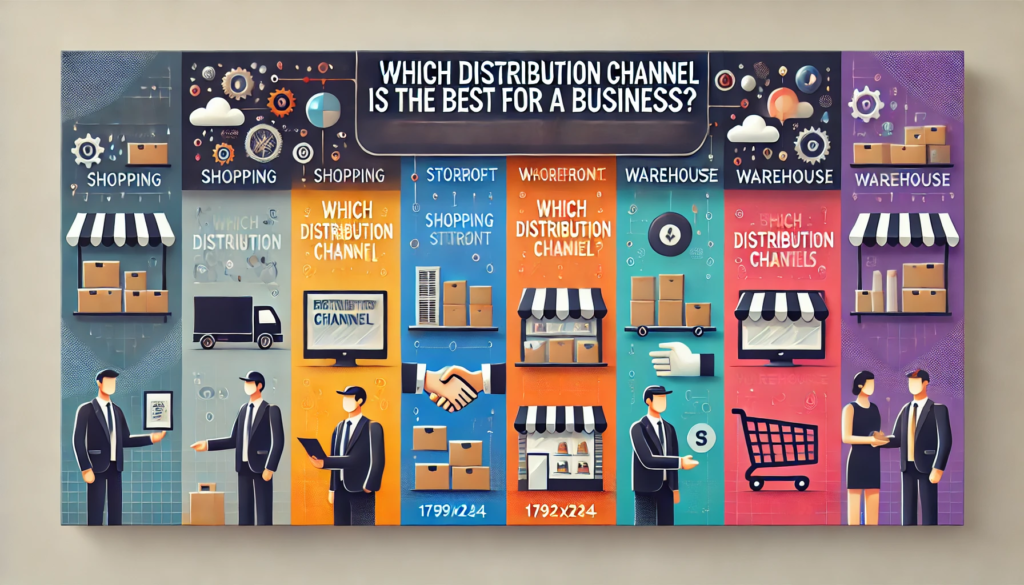
In today’s highly competitive market, choosing the right distribution channel is crucial for the success of a business. Distribution channels are pathways through which products or services flow from the manufacturer to the end consumer. The right channel can enhance a company’s reach, improve customer satisfaction, and increase profitability. But which distribution channel is the best for a business? Let’s explore the options and considerations.
Understanding Distribution Channels

Definition
A distribution channel is a pathway through which goods and services flow from the producer to the consumer. It involves a chain of intermediaries, including wholesalers, retailers, distributors, and agents, who facilitate the movement of products from the manufacturer to the end-user.
Components Of A Distribution Channel
- Producer/Manufacturer: The origin point where goods and services are created.
- Intermediaries: Entities that help move the product from the manufacturer to the consumer. They can include:
- Wholesalers: Purchase in bulk from producers and sell in smaller quantities to retailers or other businesses.
- Retailers: Sell products directly to the end consumers.
- Distributors: Distribute goods to various intermediaries, often adding value by breaking bulk and providing storage.
- Agents/Brokers: Facilitate sales between producers and wholesalers/retailers, usually without taking ownership of the goods.
- Consumers: The final recipients of the product or service.
Types Of Distribution Channels
- Direct Channel: Products are sold directly from the manufacturer to the consumer without intermediaries. Examples include online stores and company-owned retail stores.
- Indirect Channel: Involves intermediaries between the manufacturer and the consumer. Examples include wholesalers and distributors, retailers (e.g., supermarkets, department stores), value-added resellers, agents and brokers.
- Hybrid Channel: Combines both direct and indirect methods, where products are sold through multiple channels simultaneously.
Distribution Channel Levels
- Zero-Level Channel: Also known as a direct channel, where the manufacturer sells directly to the consumer (e.g., online sales, factory outlets).
- One-Level Channel: Involves one intermediary, usually a retailer (e.g., a manufacturer selling products to a retailer, who then sells to the consumer).
- Two-Level Channel: Includes two intermediaries, typically a wholesaler and a retailer (e.g., a manufacturer sells to a wholesaler, who then sells to a retailer).
- Three-Level Channel: Consists of three intermediaries, such as a wholesaler, a distributor, and a retailer (e.g., a manufacturer sells to a distributor, who sells to a wholesaler, who sells to a retailer).
Pros And Cons Of Each Distribution Channel
Direct Channel
Pros:
- Control: Manufacturers maintain complete control over the branding, pricing, and customer experience.
- Profit Margins: Higher profit margins as there are no intermediaries taking a cut.
- Customer Relationships: Direct interaction with customers can enhance relationships and improve customer satisfaction.
Cons:
- Cost: Higher costs associated with setting up and maintaining direct sales operations.
- Reach: Limited reach compared to using intermediaries who already have an established network.
- Resource Intensive: Requires significant resources in terms of logistics, marketing, and customer service.
Indirect Channel
Pros:
- Market Reach: Indirect distribution channels access to a broader market through the networks of intermediaries.
- Cost-Effective: Reduced need for extensive sales infrastructure and logistics.
- Expertise: Leverages the expertise and experience of intermediaries in sales and distribution.
Cons:
- Control: Less control over the final sales process and customer experience.
- Profit Margins: Lower profit margins due to commissions and markups by intermediaries.
- Dependency: Reliance on intermediaries can be risky if they fail to perform effectively.
Hybrid Channel
Pros:
- Flexibility: Ability to reach different customer segments through various channels.
- Market Penetration: Increased market penetration by combining direct and indirect methods.
- Risk Mitigation: Reduced risk as dependency is spread across multiple channels.
Cons:
- Complexity: It is more complex to manage multiple channels simultaneously.
- Conflict: Potential for channel conflict if intermediaries feel competition from direct sales.
- Resource Allocation: Requires careful allocation of resources to balance both channels effectively.
Which Distribution Channel Is The Best For A Business?

The best distribution channel for a business—direct, indirect, or hybrid—depends on the company’s unique needs and goals.
- Direct distribution: Offers greater control and higher profit margins, making it ideal for businesses with strong in-house capabilities.
- Indirect distribution: Leverages intermediaries, providing broader reach and reduced operational burden, which is suitable for companies looking to expand rapidly.
- Hybrid distribution: Combines both, offering flexibility and the potential to optimize the strengths of each method.
Ultimately, the choice should align with the business’s target market, resources, and strategic objectives to ensure effective product delivery and customer satisfaction.
What Are The Factors To Consider When Choosing A Distribution Channel?
- Target Market:
- Understanding the target market is essential. For instance, a luxury brand may benefit from selling directly to consumers to maintain an exclusive image, while a mass-market product might perform better through retail distribution for a broader reach.
- Product Type:
- Perishable goods, such as food items, require a fast and efficient distribution channel, often direct to retailers. Non-perishable goods, like electronics, can use a combination of direct and indirect channels.
- Cost:
- Evaluate the costs involved in each channel. Direct channels might require more investment in logistics and marketing, while indirect channels may incur costs related to commissions and reduced profit margins.
- Control:
- Determine the level of control needed over the sales process, customer experience, and brand image. Direct channels offer more control, while indirect channels might dilute brand control.
- Customer Preferences:
- Consider how your customers prefer to purchase products. Some customers value the convenience of online shopping, while others prefer the in-store experience.
- Competitive Landscape:
- Analyze how competitors distribute their products. Adopting similar channels can help in gaining market share while differentiating can create unique market positioning.
What Are The Tips For Choosing The Right Distribution Channel?
- Research Your Market:
- Conduct thorough market research to understand your customers’ buying habits, preferences, and expectations.
- Test Multiple Channels:
- Experiment with different channels to see which works best for your business. Pilot programs can provide valuable insights without significant investments.
- Leverage Technology:
- Use technology to streamline distribution processes. Inventory management systems, CRM software, and analytics tools can help optimise operations.
- Build Strong Relationships:
- Establish and maintain strong relationships with intermediaries. Clear communication, support, and collaboration can enhance the effectiveness of indirect channels.
- Monitor and Adapt:
- Continuously monitor the performance of your distribution channels. Be ready to adapt and make changes based on market trends and consumer feedback.
Case Studies: Successful Distribution Strategies
- Apple:
- Apple uses a combination of direct and indirect channels. Its direct channels include Apple Stores and its website, which provide a premium customer experience and direct interaction. Indirect channels include partnerships with major retailers and telecom providers, ensuring widespread availability.
- Amazon:
- Amazon has revolutionised e-commerce with its extensive logistics network and customer-centric approach. They use direct distribution to offer a vast array of products and indirect distribution through third-party sellers, creating a comprehensive marketplace.
- Coca-Cola:
- Coca-Cola employs a robust indirect distribution strategy. They partner with bottlers, wholesalers, and retailers worldwide, ensuring their products are available in every corner of the globe.
Frequently Asked Questions
Q1. Which distribution channel is the most stable for business usage?
Ans. Direct sales are often the most stable distribution channel for businesses, offering greater control over customer relationships and sales processes. Stability comes from eliminating intermediaries and directly engaging with customers, which helps maintain consistent quality and service standards.
Q2. What channel of distribution will help grow a small business?
Ans. E-commerce platforms, social media marketing, and local partnerships can significantly help grow a small business. These channels provide broad reach, low initial costs, and the ability to engage directly with customers, which can drive brand awareness and sales growth effectively.
Q3. What is a distribution channel for business to business?
Ans. Common B2B distribution channels include direct sales teams, wholesale distributors, and online B2B marketplaces like Alibaba or Amazon Business. These channels facilitate bulk transactions, relationship-building, and tailored services for business clients, ensuring efficient supply chain management.
Q4. How to choose a distribution channel?
Ans. Consider factors like target market, product type, cost, scalability, and competition. Analyse customer preferences and behaviours, assess the strengths and weaknesses of different channels and align your choice with your overall business strategy and objectives.
Q5. What is the most cost-effective channel of distribution?
Ans. Online marketplaces and direct-to-consumer (D2C) models are often the most cost-effective distribution channels. They minimise intermediary costs, reduce overhead expenses, and offer direct access to customers, allowing businesses to maximise margins and control pricing strategies effectively.
Conclusion
Choosing the best distribution channel for a business is not a one-size-fits-all decision. It requires a deep understanding of the market, product characteristics, and business goals. Whether opting for direct, indirect, or a combination of both, the key is to align the distribution strategy with the overall business objectives and customer needs. By carefully evaluating the pros and cons of each channel and staying adaptable to changes, businesses can find the most effective way to reach their customers and achieve long-term success.
In summary, there isn’t a definitive “best” distribution channel; rather, the optimal choice depends on various factors unique to each business. By considering the target market, product type, cost, control, customer preferences, and competitive landscape, businesses can make informed decisions that drive growth and profitability.








No Comments